Sunday, May 29. 2011
Mrs. BD and I have concluded that Umbria is a more varied and interesting place to visit than Tuscany. I have a well-travelled friend who agrees. Umbria is, except for the tourist magnets of Perugia and Assisi, off the beaten track. We have been around much of Italy in the past, and the Latin and Italian scholar lad has been literally everywhere there.We had not toured Umbria and the old Via Flaminia (which it is still called). Mrs. and I just returned home from our delightful adventure. As I get my thoughts and pics organized, I will go over some of it: History, food, geography, etc.
I do have some ideas about how to make it more interesting and educational than a totally dull photo slideshow for Maggie's. Will do my best with a multi-part series of my travel snapshot journal. Bear with me: I will try to make it interesting.
Too tired to begin that now, but here's one photo to maybe inspire some interest in my posts to come, from one of Norcia's (pronounced nor' - cha) famous pork, cheese, and Black Truffle shops. They love their aged Cinghiale meats and sausages in Umbria (Cinghiale is Wild Boar, not our American feral pig which is not too tasty). In much of Europe, wild game is sold in markets (which is illegal in the US).
The market shops always have samples of their own aged ricotta dura (a harder and delicious version of ricotta which is good for salads), their superb Pecorino from sheep milk, or of their sausages. I was tempted to smuggle a large wheel of Pecorino Dura, but decided not to test the mysterious customs laws on importation of foods.
They roll the aged ricotta in toasted wheat for a skin, as below:
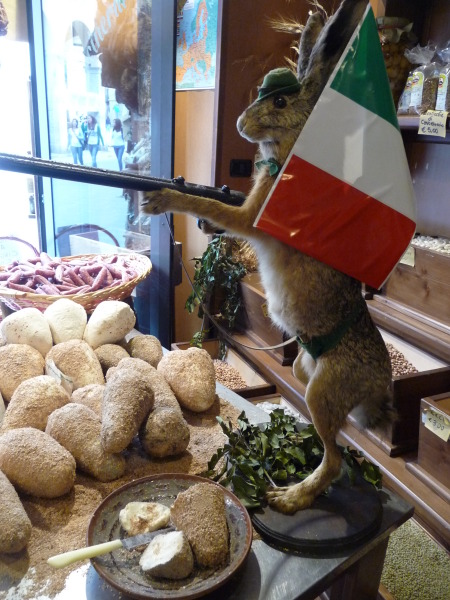
Saturday, April 16. 2011
I'm delivering food and doing errands for my old folks this weekend. My Mom fell and cracked her patella while unloading groceries, cannot drive for 6 weeks, and can barely hobble around on her brace - and my Dad is half-blind, has Parkinson's, and is not allowed to drive anymore. His ornery self refuses to take the Parkinson's medicine but, thankfully, he finally agreed to get himself a hearing aid.
A neighbor is driving Mom to her best friend's funeral today at our family church on the hill.
I brought them Chinese take-out last night: Cold hot pepper cabbage, Scallion pancakes, and Scallops with Snow Peas. Then a plate of strawberries. Also left them some black bread and Nova Salmon for breakfast. Tomorrow, I'll bring them some take out Thai soups. They look too skinny, need feeding. They were never much into eating, unless it was especially good.
Somehow, we got on the topic of past family trips. I was laughing to remember the volumes of disposable diapers we travelled with - they were not available in Europe back then. With a family of 5 kids, there was usually at least one in diapers (and at least one in a bad mood). I remember trying to help tie them (the bags of diapers, not the younger brats, unfortunately) to the roof of the rental cars. My Dad always travelled with rope for that purpose, in the pre-bungee-cord era.
My Mom was remembering the large Raspberry plantings at the Roman Camp Hotel, where we all had stayed for a few days. Watching her litter grazing on Scotland's excellent raspberries, ripping them off the rows of canes. A wonderful place. My parents are picky about where they will stay - they can't stand glitz or "fancy," and they don't do tacky. They are the typical old Yankee WASPy breed that is only comfortable with understated refinement and genteel semi-shabby. No "luxury," please. They feel that "luxury" is vulgar (whereas I can learn to appreciate it when I can find it). Mom liked this place:
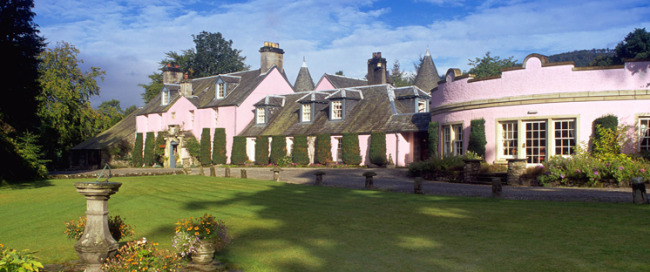
A few years after that trip, my folks did something unusual and selfishly left the kids behind and took a trip by themselves, and biked the length of Hadrian's Wall. Or, as my Dad corrects me, walls: there are two of them. They were finished with breeding. We had many good trips; lots of stories and tons of colorful memories. I can't remember them all: Somewhere in Europe every August, and Cape Cod too. Ocean liners - I remember each one of them. Two ski weeks each winter. Monhegan Island regularly. Very nice. Like those Bald Eagle parents with their rabbits and fish, I think they wanted to fill us with all of the experiences that they could, and the heck with the expense.
As much as I love my cozy home, going anywhere new, near or far, still ignites the adventurous spark in me, like a kid. I am lucky that I married an adventurous woman who will go anywhere, any time, and try anything. She back-packed down to Greece when she was in college. My kids are like that, too, thank God. They seem to view this world as a wonderful buffet of experiences, opportunities, and challenges.
I think my parents' travelling days are over, but they are fortunate to have 5 kids who want to pitch in, when needed. My favorite Thai place makes damn good noodle soups, and I am gonna fight the traffic and bring them some.
Tuesday, March 15. 2011
The BD family contains avid snorkelers, but only Mrs. BD is a skilled scuba diver. But even snorkeling, she can swim down 20 feet easily to inspect something. Loves it.
But about the peas. On good advice we bought a big bag of frozen peas at the Cabo WalMart, filled a plastic water bottle with them and then added water to the bottle. When you are diving or snorkeling near rocks or a reef, just squirt a few peas out of that bottle. You will be swarmed with tropical fish. Works like a dream. Like tossing bread to pigeons in a park. Fish were crashing into me, some over a foot long, and one bit Mrs. BD while trying to get to the pea bottle. Very cool thing to try. Wish I had had an underwater camera.
We had to go on a goofy party boat to get to a good snorkeling area, and they provided the equipment. Unlimited free drinks. It was jolly. On the way back, Mrs. BD danced the Macarena and YMCA without touching a drop of drink (not a photo of her). I didn't, and I did.
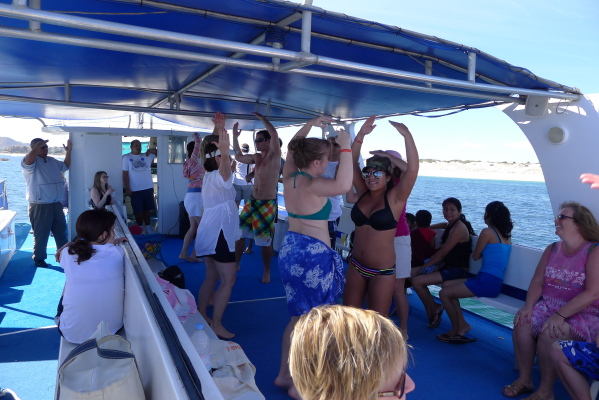
Saturday, March 12. 2011
Catrina dolls and other wonderful death dolls at Mi Casa Restaurant. They are hand-made, of painted clay appropriately enough, and expensive.
Whever I want something but have no use for it and don't want to spend the $, I just take a snap of it. Then I own it, in a way. I am trying to teach Mrs. BD that approach to things - symbolic possession by internalizing an image or idea. But does it work for designer shoes?
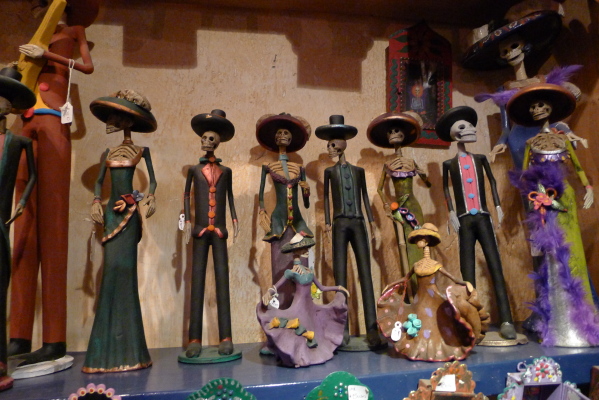
More below the fold -
Continue reading "Random Fun Cabo jumbo pic dump, #1"
Wednesday, March 9. 2011
One day last week we drove an hour or two north to Todos Santos. Todos Santos is an artsy oasis village in the desert, with a rare fresh water lagoon a few miles east, just behind the beach. Some Americans and Europeans move there to truly get away from it all for good. Like that retired CIA spook on NCIS.
Our little group had lunch at Posada La Poza, a tiny boutique hotel out in the boonies with a rooftop restaurant. We requested that they make us a mixed seafood platter of whatever they had on hand. They brought us Tuna Tostados, grilled marinated shrimp, fried scallops, and grilled Sea Bass which they cooked rare - as good fresh fish should be cooked. Salad too, with peas and corn in it. Real Mexican food. Margueritas, of course (for the Vitamin C), which they mixed on the strong side:
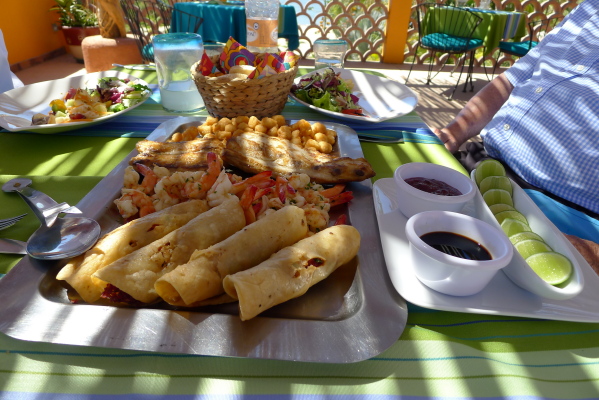
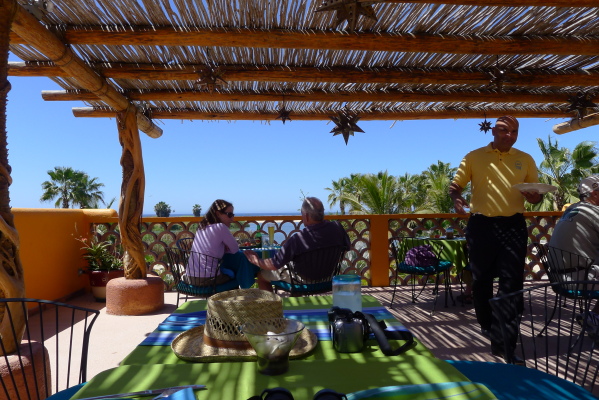
Here's the outside of Posada La Poza, where they have to turn many people away for lunch despite its remote location. They only have 5 tables for lunch -

Lots of fun pics of that side trip below the fold -
Continue reading "Lunch in Todos Santos, with birdwatching and Mexican architecture"
At 6:30 in the morning the Mrs. was down at the gym while I quietly enjoyed the view from our terrace with my idea of a good breakfast: Mexican coffee, a Cuban Romeo y Julieta, and a little tropical fruit, including avocado.
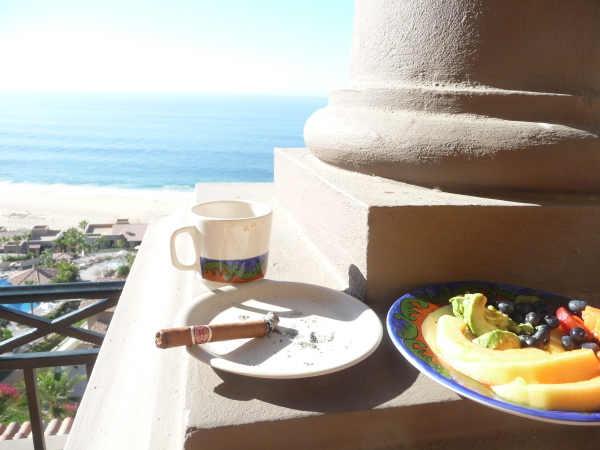
Tuesday, March 8. 2011
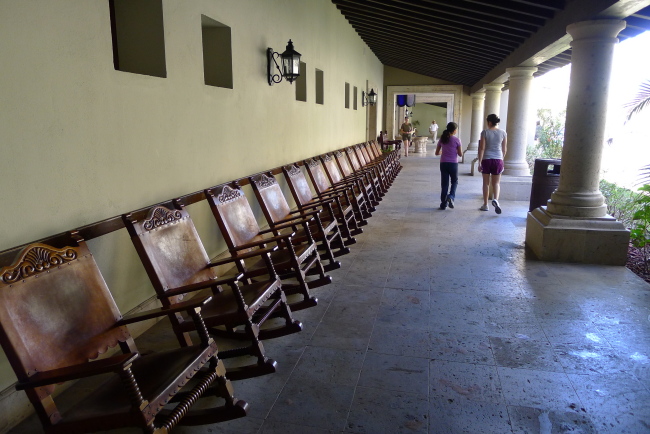
Entry porch of the place where we stayed, Pueblo Bonito Sunset Beach on the Pacific side. Lots of people with kids, but elegant, beautifully-designed, built for the ages, friendly, simple, and utterly free of any tackiness. I nicknamed the place "The Hanging Gardens of Babylon" because it's built into an oceanside cliff.
A few of my random Cabo notes:
- Baja California Sur is a desert, dominated by cactus forest habitat. There are always rocky mountains in the distance, running north-south down the long peninsula. There are no rainy days and no cloudy days except in August and September. That's what creates the huge arroyos and canyons.
- The weather is said to be similar to that of Palm Springs, but with a constant sea breeze. Cool desert nights. No humidity.
- Besides the place where we stayed, other resort hotels that seemed especially appealing were Hacienda Del Mar and Palmilla (with golf) in San Jose.
- Cabo is famous for its fishing, deep-sea and coastal. Lots of tournaments. I like to know that the Marlin and Sailfish are out there, but I don't feel much of a need to hassle a fish anymore.
- In the winter months, whales are everywhere for calving season. Gray Whales and Humpbacks. Whether you go fishing, whale-watching, or just sit on the beach, they'll be out there. On the morning we left, I watched, from our terrace, a baby Humpback leaping and cavorting like a puppy.
- Our place had seven pools, some with jacuzzi jets in the corners and some with swim-up bars. We swam in a couple of them, but I am not a pool person and did not sit by one for a minute.
- I'm not much of a resort guy either, but I have to admit that they do know how to make a vacation as comfortable, painless, and convenient as this life can be. I am adaptable, and can adjust to that for a while before I feel like chopping some wood or doing something useful.
- Overheard at night in a pool between two Texas guys with drinks in hand (the only time I heard any crude talk at all): "My f-ing wife, her neighbor gets a f-ing 20-foot Christmas tree, and she has to have a 40-foot tree. Where the f-ing f- does she thinks this money comes from?" "My wife, it's the f-ing shoes. Thousand dollar shoes, she wears them once and tells me they pinch." "Yeah, well last week my f-ing wife..."
- Once you get off the main drag, it's dirt roads everywhere. Everything is coated with dust until rain comes in August.
- Odd as it seems, Cabo is only a 2-hr time difference from the East Coast.
- The Cabo area seems to mainly attract wholesome people from the Midwest and the West Coast. I suppose it serves similar purposes to those the Caribbean, Bermuda, and Florida do for Easterners. We met a number of delightful people, and spent a good evening having drinks and learning to play Mexican Train Dominoes with them. It's a good game, and you don't have to think too hard.
- Cabo San Lucas is on the southernmost tip of the long Baja peninsula, 1000 miles south of LA. My lad drove from LA to Cabo once. Mexican roads. I would not drive those highways at night - no guardrails or shoulders, cliffs, constant detours, cattle on the highways, etc.
- The ocean-side beaches, alas, are mostly not swimmable but are surfable. They tend to have a steep drop-off with powerful churning surf, strong currents, whirlpools, and undertows. Easy for a strong swimmer to lose control. The Sea of Cortez is entirely swimmable, and swim in it we did. Mrs. BD and I like cold salt water with waves. Chillier than one might expect down there. Most people use the heated pools, and make like a Manatee.
- The old part of Cabo San Lucas and the marina are predictably touristy and honky-tonk, with some fine, relatively inexpensive restaurants. Lively at night. Almost all of the resort hotels are on the Sea of Cortez side, so if you like lots of activity, guys selling faux-Mexican junk, crowded beaches, water taxis, Sea-Doos, girl-watching, boozed-up college kids, etc., that's your place. You have to go to that side to swim in the sea though, which is what we like to do.
- You get the feeling in Mexico that many jobs are either partly completed, never completed, or just abandoned. The ramshackle, third world look becomes part of the dusty charm after a day or two. On the other hand, the jobs which involve the gringos, like the resorts and vacation homes, are done very well and with fine craftsmanship, especially the stonework.
- We saw little of what we think of as "Mexican food" in the East. Yes, they have taco stands all over for the workmen, but the food we had was excellent with nary a refried bean. Not much guacamole either, but sliced avocado on top of lots of things. Saw no lemons, but those little limes are always sliced on a plate.
Some Mexico photo dumps later.
Monday, March 7. 2011
We ate very well in Mexico. These were seafood enchiladas with a creamy wine sauce, a relish of chopped raw vegetables marinated in lime juice, and some fried plantain chips. The green salsa with the brown corn chips was tomatillo, cilantro, onion, and chilis.
Also, the necessary daily Marguerita or two, to ward off scurvy and to prevent dehydration.
(This nice lunch was at the Cilantro Restaurant, next to the Pueblo Bonito Rose resort on the Cabo San Lucas harborside beach. That's not the hotel where we stayed but it's a good one if you like to be around a lot of activity.)
I'll do a few more Mexican food posts this week.
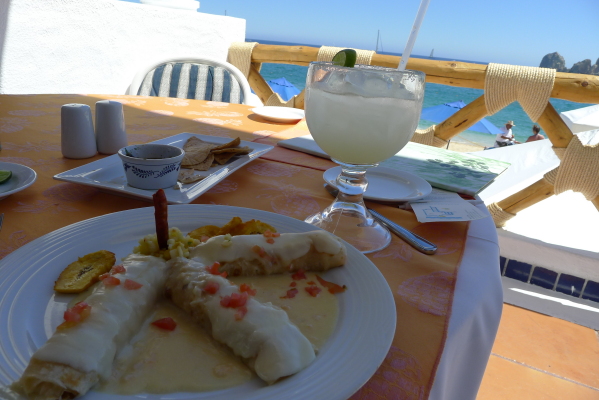
We go places and take photos to save our readers the trouble, hassle, and expense of travelling around. We do it for you!
Rolled back home to Maggie's HQ in Yankeeland at 3:15 this morning after several lengthy flight delays, stuck irritably in the Houston airport. I only have time to post one pic now - our hotel suite's terrace overlooking the quiet and peaceful Pacific side of Cabo San Lucas (as opposed to the Sea of Cortez side). Very pleasant to step into your palatial suite (His and Hers bathrooms, daily sheet changes, hot and cold-running help, chilled Pacificos on hand with lime slices, etc) and to see this sight (decadent hot tub out of sight on the left):
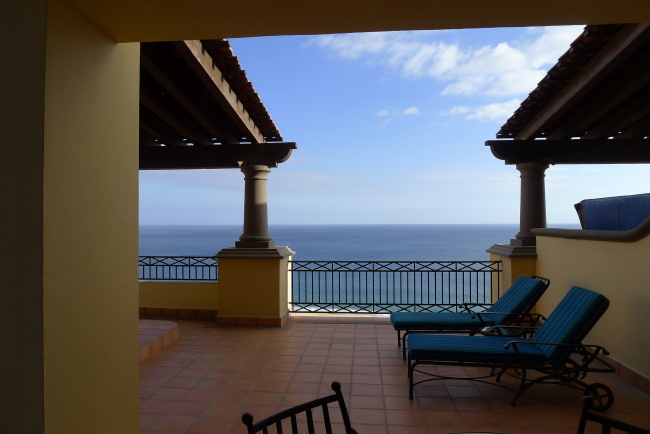
I found Baja Sur to be interesting in many ways. I'll get to my many pics and thoughts about it over the next few days. And yes, Capt. Tom and Dr. Merc, I did do a little fishin' - but just coastal fishing for dinner.
Morning links later today, if I can get my brain in order.
Saturday, March 5. 2011
Here's a vacation idea: Villas in Tuscany or Umbria. Not expensive, either. Chefs available to do the cooking.
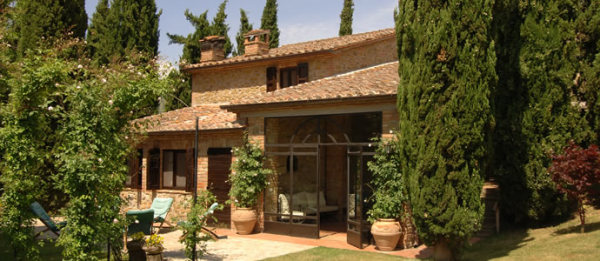
Thursday, December 2. 2010
It's riverboat European travel. Maggie's recommends. It's a hassle-free way to travel, and boats are just plain fun. It's not grande luxe by limousine Liberal standards (ie each room does not have its own hot tub or bar - so John Kerry wouldn't like it), but it's plenty comfortable enough for any normal American Republican. Friendly, too, and great local food.
We loved travelling with them.
Monday, September 20. 2010
Mrs. BD found this good deal from our friends at Club ABC: 8 days in Prague and Budapest. They do a very good job making world travel possible for the non-weathy and for those who are willing to fly economy and maybe endure a stopover.
I've always been more of a Mediterranean and UK traveller, but the Holy Roman Empire is growing on me. It's probably just a phase.
You can make online reservations for music and opera tickets way in advance. She wants to see Janacek's Kat'a Kabanova at the Prague Opera (where Mozart first conducted Don Giovanni).
I have never been to Hungary. Mrs. BD wants to see Hungarian folk music and dance troupes, and try some of the historic coffee houses. Here's a nice Budapest restaurant. Looks just like I would expect:

Thank God that the commies are gone from Czecho and Hungary. Maybe Cuba will be next.
Amusingly, they do have a Hammer and Sickle Times tours in Budapest. Join us, Comrades and ex-Liberals:
Go back to the good old times to experience how life was when Big Brother ruled our every move, we drove Trabants, drank spirits at work, lived in block flats, stood in banana lines, had two passports, coupon books, no TV on Mondays and no freedom of speech! Written and raved about every year in major newspapers around the world, don't miss out on this bygone era.
They also have this more cheerful tour: Historical Revolution Walk. This one is about the good guys.
Saturday, September 18. 2010
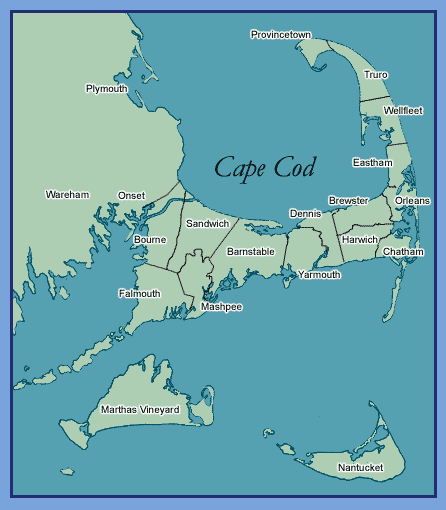
We showed our dear friends around the Outer Cape (aka Lower Cape) last weekend, and I hope they got a sense of why it is enchanting to some of us. (They had a chance to look up some dead ancestors too.) We walked quite a bit, tooks lots of snaps, consumed quite a bit of seafood, ran into some interesting and friendly folks.
Re nomenclature, Wiki correctly notes:
The terms "Upper" and "Lower" as applied to the Cape have nothing to do with north and south. Instead, they derive from maritime convention at the time when the principal means of transportation involved watercraft, and the prevailing westerly winds meant that a boat with sails traveling northeast in Cape Cod Bay would have the wind at its back and thus be going downwind, while a craft sailing southwest would be going against the wind, or upwind. Similarly, on nearby Martha's Vineyard, "Up Island" still is the western section and "Down Island" is to the east, and in Maine, "Down East" is similarly defined by the winds and currents.
Over time, the reasons for the traditional nomenclature became unfamiliar and their meaning obscure. Late in the 1900s, new arrivals began calling towns from Eastham to Provincetown the "Outer Cape", yet another geographic descriptor which is still in use, as is the "Inner Cape."
Anyway, as I was saying, we love it because it is simple, a little bit wild and woolly, small-"d" democratic, and without pretension, fashion, or name-droppability. Even the wealth up there on the Outer Cape quietly adheres to the Yankee Code (and when they do not, they catch hell).
Lots of pics with commentary below the fold -
Continue reading "The Outer (Lower) Cape: Eastham to P'town"
Thursday, September 16. 2010
The oyster farmers get out onto the mudflats at low tide, with their trucks and boats, to tend their oyster cages or to harvest the humble but tasty Wellfleet Oyster:

One of many vast Wellfleet salt marshes. These are happy homes for Diamondback Terrapins, on the northern edge of their range. I think they hunker down in the mud at low tide, then come out to feed on worms, crabs, and snails when the water comes back in. They never leave the water except to lay their eggs, and are rarely seen. Some Mallards and Black Ducks breed there, but you never see many ducks up there until winter, when the sea ducks come down from the north in large numbers - Eider, Old Squaw, and all of the Scoters.
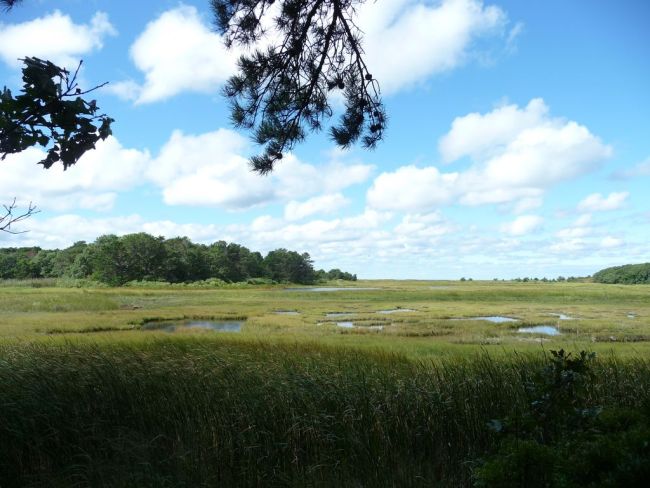
Miles of "empty" beach. This is on Cape Cod Bay, roughly across from Plymouth. Endangered Piping Plovers breed along this stretch of beach. Montana is not the only place with big skies (but we do love Montana - been there many times).
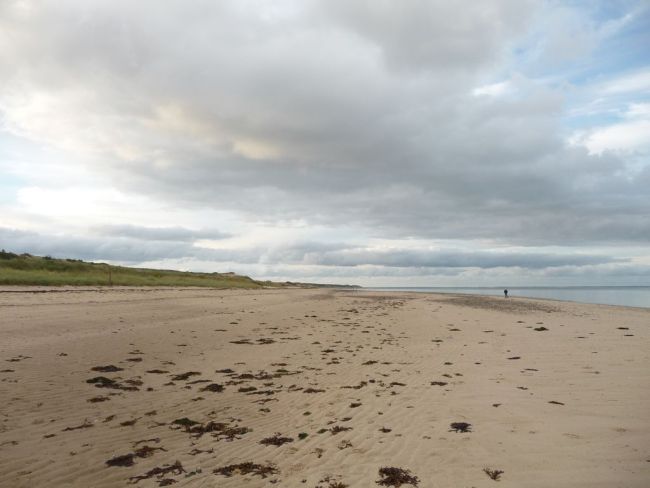
Monday, September 13. 2010
Monastery on a hill overlooking the Danube, early morning light, a few weeks ago. No, the Danube ain't blue.
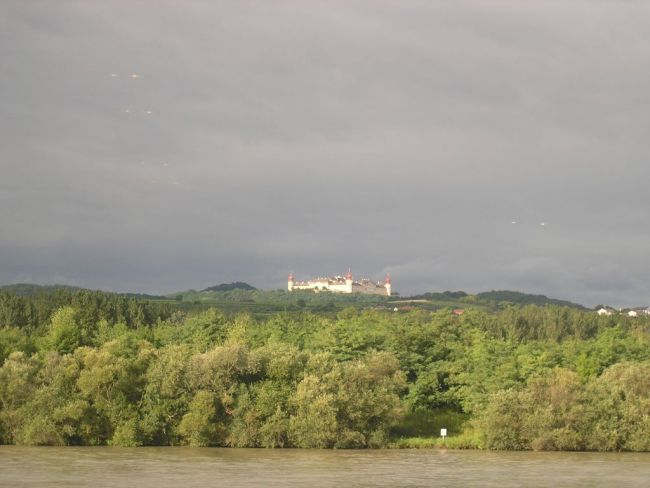
Thursday, September 9. 2010
In a farming hamlet outside Deggendorf. Frequently, the farmers live in little hamlets and drive their equipment to their barns or land to work. Like non-agribusiness farmers in the US, they often supplement their incomes with other work (such as driving school buses, running booths at Oktoberfest, driving tourists around in horse-drawn wagons, etc). I noticed a keg with spigot and cups inside one cow barn, leading me to believe that either the farm workers or the cattle drink beer on the job.
I will dribble out some last few interesting trip pics as I find them in my screwed-up photo files.
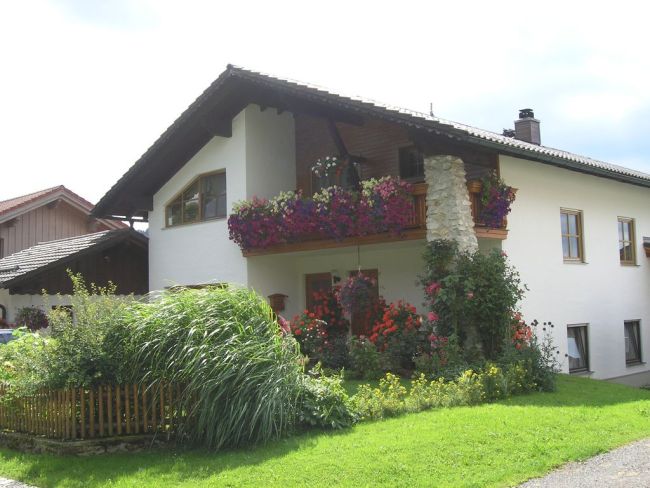
Monday, September 6. 2010
It was wonderful to have the entire BD family with us, including Mrs. BD's parents and the precious new daughter in law. Special times. Got to grab them. Ars longa, vita brevis, and all that. A fine trip for us history buffs, beer-tasters, and relentless walkers. As usual, we walked our butts off and I was glad to have my ugly old man walkin' shoes to alternate with my elegant New Balance sneakers.
Today's first snap is for our down-under reader, who ate here recently. The Weissbrauhaus in Regensburg. Superb fresh Weissbrau and famous for its sausages. You can see my hearty lunch below the fold, along with my entire final fun photo dump with ignorant comments from this year's Big Trip.
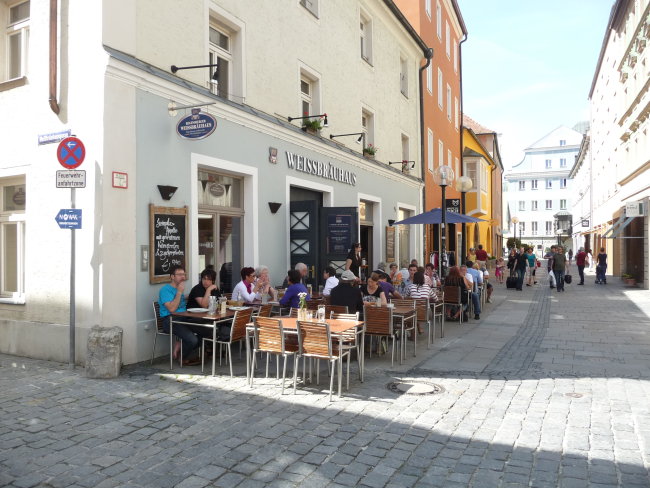
Continue reading "Final giant Danube trip photo dump. Some good stuff in here plus a creepy pic of Nuremberg"
Friday, September 3. 2010
I dedicate this post to our pal Sippican, who knows a lot more about archeetekcher than I do.
What does Pope Benedict have to do with Regensburg? Plenty.
Plus the town is Germany's medieval gem (and was not bombed by the Allies). It would be a very pleasant town to live in.
The great gothic St. Peter's (c. 1240) is fine, but we found this small parish church, not a tourist site, Ulrichskirche (also 1200s I believe), which is next door to the cathedral, interesting from a detective standpoint. Take a look at the bastardised architecture and decor.
What first struck us on entering was that the church organist was practicing, noodling on his old German pipe organ with comfortable recessional noises. Great.
Second thought was "What the heck is this?"
Well, clearly somebody in the 1700's decided to gussy up the old-fashioned, gothic-ish church with Baroque. Redecorating. Squared the old columns, added squigglies to them, new baroque pulpit, and painted over the old gothic paint and stone.
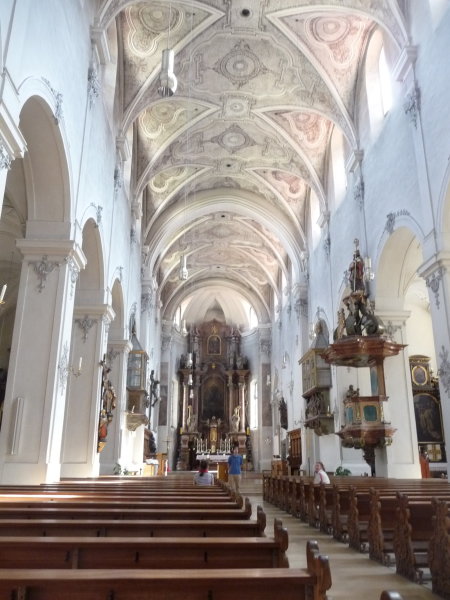
More interesting architectural detail below the fold -
Continue reading "St. Ulrich's and architectural fashion"
Monday, August 30. 2010
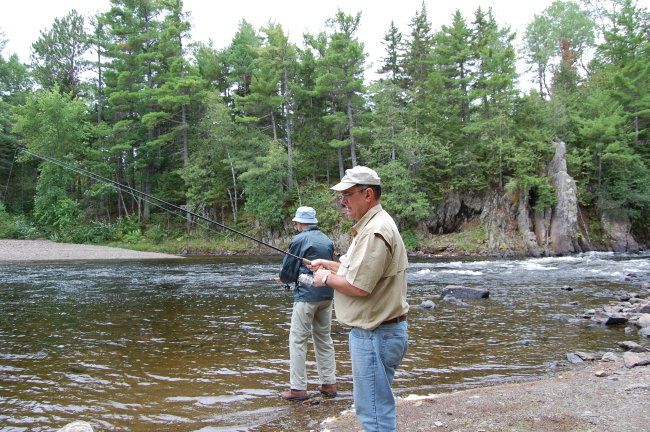
Bird Dog -
While certainly not as "dramatic" as your trip across the pond, we spent a week in the Maine woods, canoeing and fishing for Brook Trout and Smallmouth. We stayed at a traditional Maine "camp" http://www.bowlincamps.com/ Food was great (camp cooking and plenty of it). Other than rain for 1/2 the day on Monday, the weather was superb - temps in the upper 70's during the day and 50-55 at night. Camp is located 8 miles down a logging road (no cell phone or Blackberry - hooray!) and about an hour west of Patten, Maine. They have had little rain this year, so the river and stream levels were down, impacting the fishing. We caught some Brookies and one decent Smallmouth in five days of fishing. The fish were there, we just had to work for them. We canoed and fished the East Branch of the Penobscot River which is pretty daggone wild. We saw no other canoes or campers on the river. Saw a nice bear and wife almost got ran over by a moose while she was hiking. Had a flat tire on the Suburban so had to go to Houlton for repair (living where I do, I forget how nice the folks outside of the urban areas are to strangers. Guy at the tire shop just happened to have the exact size and make tire that matched the other three. It was used, but had better tread than the ones on the Sub. $50 on the vehicle. In and out in 45 minutes.)
Bowlin Camps is just a stone's throw from the Appalachian Trail. Guy came through for lunch - he was hiking from Gaspe Bay to Key West. Left Gaspe Bay in mid-June. No map, one pair of boots and I think, not a lot of money. Gave him our breakfast bars and some trail mix, for which he was sincerely grateful. Seemed like a nice guy, but maybe a bit too idealistic - hoped to make it to Key West by next summer.
Anyway, the camp was great, Pops, wife and the two dogs enjoyed themselves in the woods. We had hot showers, generator between 0630 and 2100 hours and gas lamps otherwise. Camp was getting ready for bear hunting season, which begins on August 30th. We saw several trail cam pics of bears that were 5-6 feet tall, which is a great black bear for Maine.
Couple of pics attached.
Your humble scribe - J
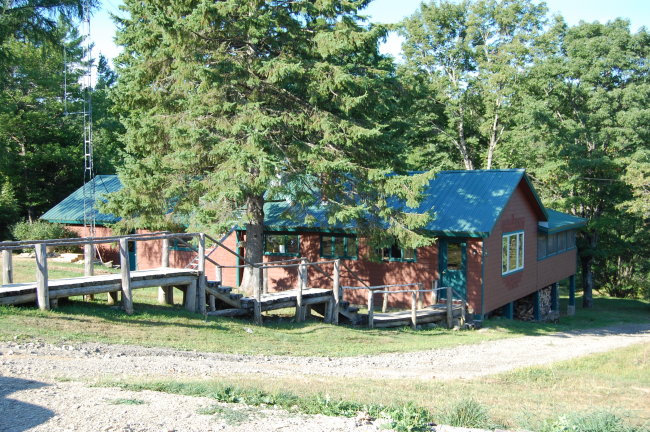
Sunday, August 29. 2010
 One place we did not get to on our trip was Salzburg. Wish we had had time to visit that medieval city which, as its name implies, got rich selling and transporting salt down the river. One place we did not get to on our trip was Salzburg. Wish we had had time to visit that medieval city which, as its name implies, got rich selling and transporting salt down the river.
Our guide pointed out to us how important salt was at the time - not as a condiment, but as a food-preservative. "White gold."
I wonder what salt mines were like in 1400.
Saturday, August 28. 2010
We became somewhat expert in locks. When we got to the Rhine-Main-Danube Canal, we took locks uphill over the continental divide, then down the other side. An engineering marvel. It's all gravity-driven and, as I have said, you can travel from the North Sea and Amsterdam to the Black Sea, by water, today. That trip would be a fine 30-day vacation.
The width of ships and barges is limited by the width of the locks, and the height is limited by bridges. In some locks, we only had about 6" space between the walls. I asked the Captain how he managed to get into those tight ones without scraping the sides. He laughed, said "You just go straight." (Our ship had a joystick like a Hinckley Picnic Boat, not a wheel. Bow thrusters, but no stern thrusters because the driver could turn the props to 90 degrees.)
I hear you asking what music our Dutch Captain liked to listen to when he had the con. Seemed like he was partial to Mark Knopfler and Van Morrison. Chugging up the Danube, listening to "We gotta move these refrigerators..." was memorable. I thought some Creedence might have been good, but maybe trite.
He had read some Mark Twain, said he liked Life on the Mississippi. Our Captain was a hearty and cheerful bloke who liked his wine and beer when off-duty. It seemed that the crew and staff responded well to his upbeat attitude towards life, making for a happy boat. Good cheer is contagious. Negativity is a plague. He constantly displayed warmth and appreciation towards his crew, but you cannot be a Captain without having a tough and serious core. As Dr. Bliss would say, not everybody is made for that.
Photo inside one of the many locks we went through.
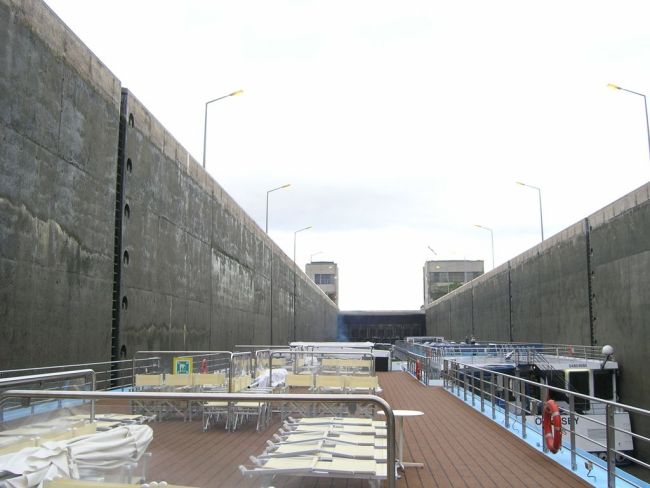 \ \
Lots of pics below the fold -
Continue reading "Locks, and other miscellaneous trip pics"
Wednesday, August 25. 2010
You go to the home of Strauss, Beethoven, Mozart, and Haydn, and so you naturally want to hear some of their music there. That was good.
However, what was most mind-boggling for me (and my son) was the Breughel collection at the Kunst Historische Museum:
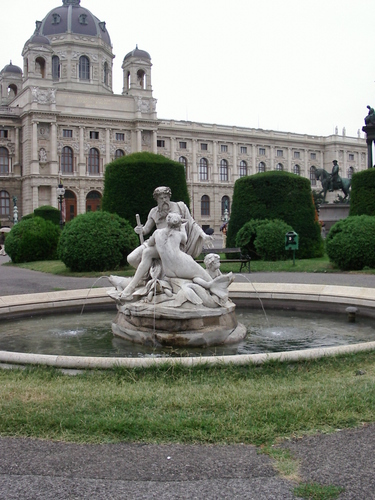
It was a long, jet-lagged and befuddled but scenic trek to get there on our first day after a sleepless plane ride, but our Breughel mission was worth it to get close to those pictures. They have a third of the existing Breughels. They are quite large paintings with many small details, and no reproductions can do them justice. Some are oil on board, and some are tempera. You have to go and see with your own eyes. They have comfy leather sofas to sit on, too.
Pictures tell stories. If they don't, they are just "design." That's my opinion, anyway. People sure do love stories, especially when well-designed. I do not mean to disparage design: Picasso was a master of design. Matisse too, and the genius cave painters of Lascaux.
Hunters in the Snow (1565), his haunting hunting masterpiece:
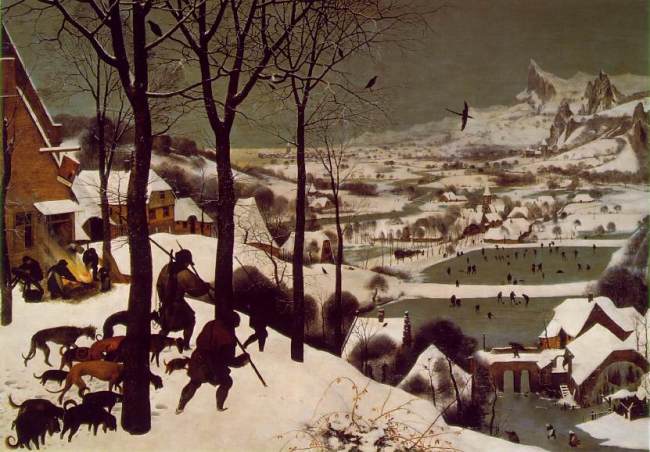
Peasant Wedding, another masterpiece:
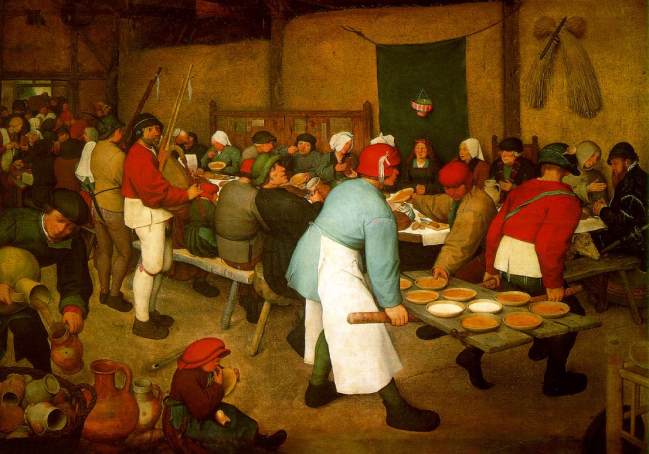
A good summary of Breughel's career here. It's interesting to me that the wealthy churchmen and princes of Austria found this Flemish painter's work so collectible. I guess they just had good taste in art.

Instead, some more thoughts collected from our trip. A Part 2 of my Guten Morgen post.
- Next time I travel with a group of family or friends, I will bring my 5-mile walkie-talkies that I use for hunting trips. A great way to call in and say "Want to meet for lunch?', since each subgroup seems to go off in their own direction.
- I forgot to mention how immaculate the bathrooms are. And, unlike NYC, you can just walk into any cafe and use theirs. They don't mind.
- I was amazed by how many people are crippled, hobbling around on crutches or in wheelchairs. Young and old. It made it clear to me how socialized medicine saves money on orthopedic procedures. In Regensburg I saw a pregnant young lady with, I think, moderate scoliosis, wobbling around town on two crutches, carrying a bag of groceries. That would never happen in America, even if poor. HSS would fix her up overnight - and thank her for the privilege.
- The vast majority of Austrians, and Bavarians too, are Roman Catholic. They go to church. Some Lutherans in Bavaria, and some Evangelical Lutherans too. Their old churches are still alive - not museums.
- If Freud had not been a Jew, he would never have come up with Psychoanalytic theory. Despite being a prominent young Neurologist and researcher/scholar, a Jew could not be appointed Professor in Vienna. The Gentile docs just referred him the wacky patients they did not want to bother with, so he decided to try to listen to them and to try to make sense of what ailed them. Had he not been a Jew, he would have been a wealthy Herr Professor of Neurology. Necessity is the mother of invention.
- Riverboat cruising has become a big deal over the past ten years. It's really a new form of vacation travel. I like it. I love ships and boats in general. No moving from hotel to train to hotel to car, and you always have guides right there when you want them. Our boat cruised back and forth between Budapest and Amsterdam, but most people just did legs of the trip (as we did). The boat had plenty of bikes to use, too. Just sign up for them.
- Wiener Schnitzel: I still don't get what is supposed to be so good about this cardboard-like food. Why do people eat it?
- Kesler reminded me of a thought I had had, regarding our deep Germanic cultural roots. (By "our" I mean especially Brit, Swiss, American, Aussie, Canadian, Dutch, etc.) Even our language is Germanic, not to mention our meat-and-potato diet. German is the easiest language for English-speakers to learn, and these folks live, act, and work like Americans. Quite a cultural contrast with Italians, French, and Spanish.
- One of the things that makes German and Austrian beers so good, over there in the biergartens, is that they are fresh, usually unpasteurized, and often unfiltered. Makes a big difference. Our big brand American beers really are not very tasty - but you knew that. Is Coors Lite or Bud Lite the best-selling "beer" in the US?
- Did we shop and buy stuff? Darn little. Mrs. BD bought a bracelet in Regensburg for 14 Euros. My daughter bought a cheese serving plate. I bought two sets of beer glasses from pubs, and a couple of beer mugs from a biergarten, all for 2-3 Euros each. Oh, also bought an umbrella at Schonbrunn when it started raining, but we left it behind somewhere after two days. Photos and experiences are what I like to bring home.
- Random factoid: The remarkable Marcus Aurelius died in Vindobona (now Wien - Vienna) while touring the edges of the empire. He was always at war with the Germans, but Roman civilization never extended much north of the barrier of the Danube.
Photo: Passau again, from the Oberhaus. I especially enjoyed Passau and Regensburg. Note the rotting mess of a 1960s-era, now-abandoned cafe up there on the left, while the c. 900 castle and fortifications stand strong and proud. Note also, from a high vantage point, how clear the demarcation is between town and country. No sprawl. That's their land use laws at work.
Tuesday, August 24. 2010
More disorganized snaps from our trip. This is steaming through the green Wachau Valley in early morning fog and drizzle.
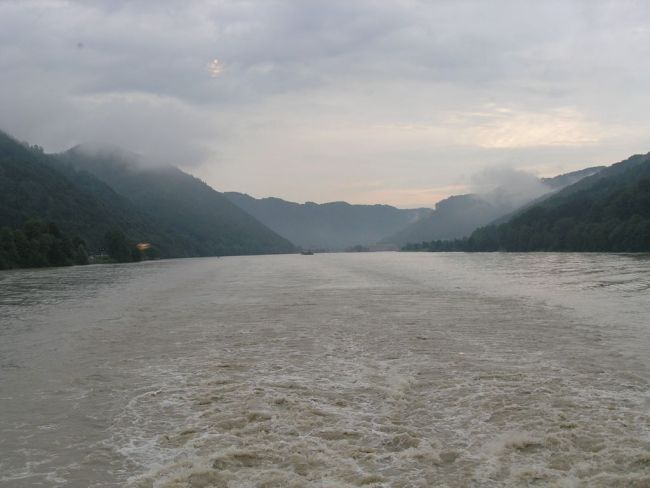
More pics below the fold -
Continue reading "A second, bigger photo dump of Austria and Bavaria, including Freud's potty"
|






 One place we did not get to on our trip was
One place we did not get to on our trip was

